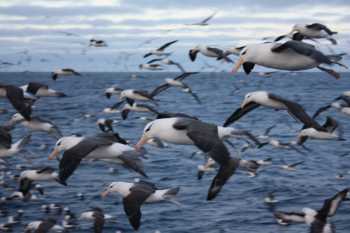Sebastián Jiménez (Proyecto Albatros y Petreles - Uruguay) and colleagues, writing in the journal Aquatic Conservation: Marine and Freshwater Ecosystems, have looked at how smaller petrels can bring baited longline hooks towards the surface where they become within the reach of shallower-diving albatrosses.
The paper's abstract follows:
1. Species of petrels and shearwaters with high diving ability could facilitate the catch of albatrosses in pelagic longline fisheries, because they retrieve bait to the surface from depths that albatrosses cannot reach. Once on the surface, large seabirds such as albatrosses can easily displace smaller species thus gaining access to baited hooks which increases their likelihood of getting caught.
2. This paper evaluates the extent to which diving species (i.e. Procellaria aequinoctialis, Procellaria conspicillata and Puffinus gravis) increase the susceptibility of albatross to bycatch in pelagic longline fisheries. In 48 sets, attacks on baits were quantified. When more than one bird (of the same or different species) tried to attack the same bait this was defined as a multiple attack.
3. There were 384 attacks on baits, of which 260 were made by a single individual and 124 by more than one. Multiple attacks were the largest source of bycatch of albatrosses (22 of 27 albatrosses whose attacks were observed).
4. Of the baits attacked by albatrosses (n =244), 17% were indirectly facilitated by diving medium-sized petrels. Considering only the multiple attacks in which albatrosses participated (n=114), 36% were initiated by these medium-sized petrels. Eleven (41%) of the albatrosses captured, and whose attacks were observed, resulted from a diving medium-sized seabird species first having contacted the terminal tackle.
5. This paper shows that medium-sized petrels, with a strong ability to dive, increase considerably the access to bait, and indirectly, the incidental bycatch of albatrosses. Observations made in the absence of mitigation measures also provide useful information to improve the performance of tori lines. Based on the seabird behaviour, it is recommended that tori lines should have a minimum aerial coverage of 50 m."

Black-browed Allbatross congregate behind a fishing vessel
Photograph by Graham Parker
Reference:
Jiménez, S., Domingo, A., Abreu, M. & Brazeiro, A. 2012. Bycatch susceptibility in pelagic longline fisheries: are albatrosses affected by the diving behaviour of medium-sized petrels? . DOI: 10.1002/aqc.2242.
John Cooper, ACAP Information Officer, 29 April 2012

 Français
Français  English
English  Español
Español